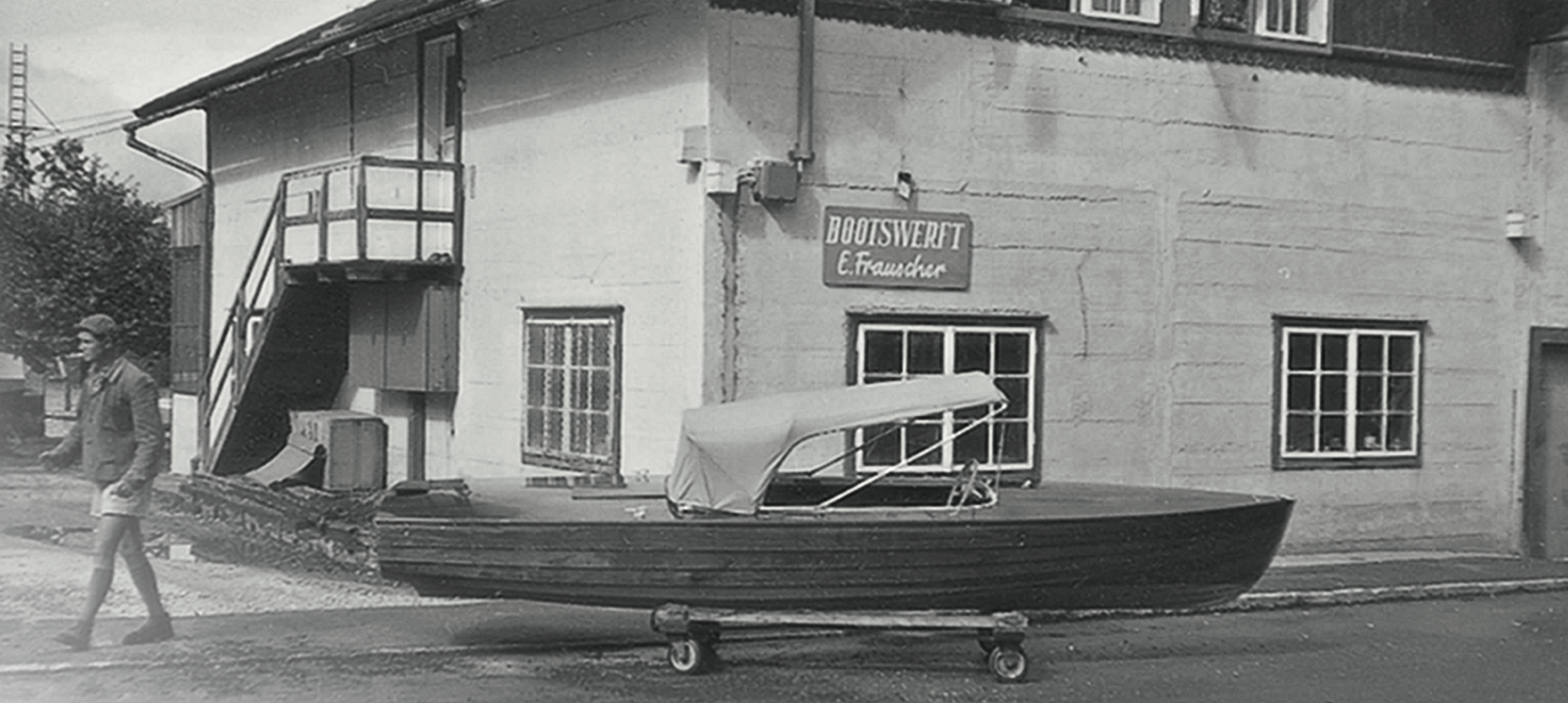
THE MAGIC OF AN IDEA ENGELBERT FRAUSCHER, A BOAT BUILDING PIONEER
When you hear the words “Frauscher shipyard”, you think of beautiful boats, a lifestyle far from everyday life, and water – that special element that has captivated the Frauschers for many generations.
There must be something in the family genes to have kept this fire for aesthetics and exquisite functionality, ignited by Engelbert Frauscher in 1927, burning for many years. A passion that now sees the Frauscher shipyard in the hands of the third generation of the founding family – and the “engineers of emotions” on the Lake Traunsee more popular than ever. But where do the roots of this passion stem from? This utter dedication continues to excite fans of Frauscher boats to this day. Let’s take a look back in time.
Engelbert Frauscher, boat building pioneer
The namesake of the world-famous Frauscher shipyard, Engelbert, was born in Aspach in 1903. He developed a love for the wonderful material of wood at an early age and learnt the art of joinery from his uncle. Engelbert Frauscher then went on to gain experience in boat building at the company Ratz in the Austrian town of St. Gilgen, and that’s where his passion was ignited. He had found his true calling and went on to work for various businesses between 1923 and 1926, learning the trade of boat building from scratch.
His “own boss” – a boatbuilder on the Old Danube
With his passion for the craft, it wasn’t long before Engelbert began to make his dreams a reality: In 1927, he took over a “boat workshop” on the Old Danube in Vienna. After a short break in South America in 1933, he returned to the Old Danube that same year to pick up where he left off. His day-to-day work mainly involved rowing boats and sailing boats, but he also built two O-Jolle boats for the Austrian Sailing Federation, which were used in the 1936 Olympic Games in Berlin.
Back to the roots – Geinberg
After all this success, Engelbert Frauscher was struck by tragedy in 1944, when his workshop along with his home next door was severely damaged by a bomb. His eldest son, 17-year-old Kurt, was also conscripted into the military and was reported as missing after the war ended. Fanny, his wife, had moved to Geinberg in Upper Austria with their two younger sons – Ernst and Hans – to stay with relatives, so he decided to bid farewell to the Old Danube and passed on the business to his apprentice of many years. His new destination: Geinberg and his family.
From boatbuilder to shipyard owner
The next successful chapter in Engelbert’s story came about through a lucky coincidence. Gmunden was under American control after the war, and the American occupiers inherited the local yacht club as a result. As they had neither the time nor the desire to manage all the boats at the club, a suitable boat- builder was sought – and who better than Engelbert Frauscher?
Engelbert Frauscher established himself as a man for all seasons at the “Gmunden yacht club” and took care of the maintenance of the boats there. He worked and slept at the shipyard in Weyer, Gmunden. Engelbert Frauscher worked day and night. As a curious fact, the Frauscher harbour can still be found on this site today.
After the Americans left Gmunden, the boats were returned to their owners and the shipyard was sold. Mr Schmid, in his capacity as a member of the yacht club, became the new owner and sold the shipyard to Engelbert Frauscher at a very favourable rate. Why? For the simple reason that the yacht club needed a skilled and experienced boatbuilder nearby. And so Engelbert Frauscher became the proud owner of his own shipyard. He carried out repairs, built small rowing boats and started to build O-Jolle boats once again. His wife, Fanny, completed the company – taking care of the finances.
It’s a steep journey to the top
The foundations had now been laid for what would become a successful business. Another important step towards this bright future was the acquisition of a rowing boat rental business. Engelbert Frauscher’s sons, Ernst and Hans, ran this boat rental business every summer. Engelbert Frauscher and his team were constantly innovating and coming up with new ideas, discovering new directions to take the business in. The shipyard flourished. Rowing boats and wooden electric boats were launched. The first motor boats – “Fish” and “Starfish” – were added to the port- folio. Ernst also joined the company, followed by his younger brother Hans Frauscher in 1954.
The next generation: Hans and Ernst Frauscher
It was now time for the next generation to come on board, with Ernst and Hans Frauscher breathing new life into the com- pany. Indeed, Hans Frauscher, the youn- gest son and a passionate water skier, has won consecutive titles in the sport. At home in Gmunden, he was also a first- class pyramid rider and skilled barefoot rider. The result: a run at the new water- skiing school. The business continued to develop at pace, with the establishment of a successful sailing school by Hans and Dorothea Frauscher and the construction of a second boathouse providing a fantastic tailwind. The portfolio was later expanded to include the sale of sailing and motor boat accessories and sailing gear.
The birth of a new idea: polyester boats
In 1968, Ernst Frauscher built a large buil- ding right by the lake. It contained a work- shop as well as the family’s private accom- modation and the entire shipyard offices. On the second floor, Ernst’s wife Elisabeth set up and ran a holiday accommodation for sailors. The next milestone came in 1971: Hans Frauscher came up with the idea of building polyester boats.

